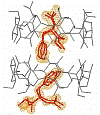Chemistry, Department of: Faculty Series

John J. Stezowski Publications
Document Type
Article
Date of this Version
January 1980
Abstract
Single crystals of the black phenothiazine : pyromellitic dianhydride (PTZ:PMDA) 1:1 donor–acceptor complex, have been grown by sublimation from the zone-refined components. The PTZ:PMDA complex crystalizes with PĪ symmetry (Z = 2), a = 7.197(1), b = 19.072(5), c = 6.886(1) Å, α = 84.79(1) °, β = 72.98(1) °, γ = 85.72(2) ° at T = 23 °C. The crystal structure model was refined with 5214 data { (sin ζ/λ)max = 0.8071 Å–1} to give R = 0.049 and Rw = 0.089. The crystal packing consists of two polar endless ...DADA... stacks related to one another by Ī. The packing is compared with that in the analogous anthracene : PMDA complex. The PTZ molecule displays a modest fold about the N...S axis (dihedral angle 176.4°), however, the deviation from planarity is small in comparison with that in PTZ crystals. The stack axis is nearly perpendicular to the molecular planes, consequently the CT-dichroism lies essentially in the principal axis system of the indicatrix. The absorption edge is not very sharp, even at 4.2 K; it is located at 900 ± 25 nm. This value is compared to the ionization energy of PTZ and to the energy of the CT transition in anthracene : PMDA. No optical emission could be detected; the pathways of radiationless deactivation are discussed in terms of CT–vibron coupling. An intrinsic dark conductivity of σ~10–12 Ω–1 cm–1 was found. It is consistent with the value of the band gap (1.7 eV) obtained both from the measured activation energy of the dark conductivity and from the estimated thermal dissociation of CT excitons. Possible implications of the polar stacking on the excitonic energy levels and energy transport are briefly discussed.


Comments
Published in The Journal of Chemical Physics (January 15, 1980) Volume 72, Issue 2, pp. 1244-1255. Copyright 1980 by The American Institute of Physics. Used by permission. doi:10.1063/1.439185